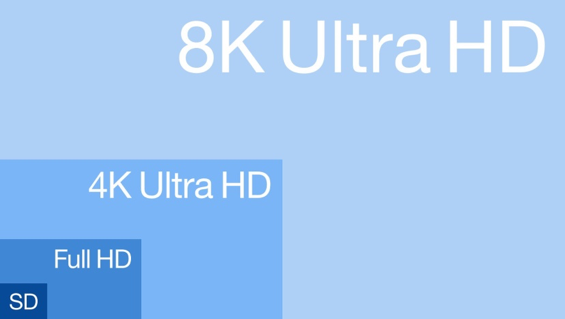Challenge called 8K Ultra HD
The first time that I heard about experimenting with 8K was about 6 years ago and it took another 3 years before I saw a native 8K resolution on a single screen. It was at the NAB show in 2014 where NHK (Japanese national broadcaster) had a booth in the future zone and I have to say that I was really impressed and said to myself that it would be great to watch the ice hockey championship on it in our pub.
Since that time 8K hasn’t expanded at all and it is still thought of as “future” technology. Even 6 months ago it was almost impossible to get reasonable 8K content in high quality and 8K TVs/monitors were not available at acceptable prices even for professionals. However people behind the scenes are making progress and things are changing (slowly). In last couple of months, Dell has introduced the first 8K monitor and RED camera has already started to ship their 8K cameras. What’s more, RED camera gave a gift to all developers involved in 8K when they made 8K footage available for free.
Now, let’s talk more about 8K itself… at the beginning it’s good to understand what resolutions are behind the 8K label. Mostly we talk about 7680×4320 and 8192×4320 which contain 4 times more pixels than 4K alternatives (3840×2160 and 4096×2160), not only 2 times like the label can evoke.

4x more pixels means 4x more data (uncompressed), which creates a 4x higher bitrate in the same frame rate. In numbers it is 50.6 MB per 4K frame (4096×2160, 4:4:4, 16 bit), which creates a 2.9 GB/s bandwidth in 60 FPS. On the other hand, for 8K it is 202.5 MB per frame (8192×4320) and the bandwidth is 12.2 GB/s (60 FPS).
Considering the current speed of PC hardware components, e.g. PCIe bus, cables, network interface, SSD, etc., it is great challenge to handle 12.2 GB/s, which makes even 8K playout quite difficult (12.2 GB/s is very close to a real throughput of PCIe 3.0 x16). Fortunately, there are only few cases when it’s necessary to handle uncompressed video and in all other cases we can use high quality compression (lossy or lossless).
The speed of hardware is one thing; another is whether 8K videos can be managed in the same way as 4K, whether the same codecs can be used, whether content creators can collaborate in the same way, etc.
Nowadays, 4K workflows are quite complex and contains some shortcuts which help to improve content creators’ experience e.g. “proxy” files. Editing software (e.g. Adobe Premiere) allows the creation of a “proxy” file, which contains the same content in lower quality and/or resolution. In the case that it is not necessary to have full quality then a proxy file can be used. Of course it brings advantages when post processing can be smoother; on the other hand it extends the complexity of the whole workflow because you need to manage multiple copies of the same video. Moreover it requires additional transcoding time and storage space.
The whole proxy ecosystem was created because widely used codecs are not fast enough for real time full resolution 4K/8K post processing. One of the reasons is that these codecs usually do not offer advanced features, e.g. resolution and quality scalability, which allow storing multiple resolutions / quality layers in the same file, or the performance benefit from them is insignificant.
Now I would like to briefly discuss what resolution scalability is. For that purpose I use that image below, which represents a file of one 8K frame. The file is split into four parts which show how different resolutions are stored in a JPEG2000 file. To be able to decode an image into a certain resolution it is necessary to decode all parts from the left until the target resolution, e.g. for HD it is the first two parts, for 4K, the first three parts. Of course, to obtain full 8K resolution it is necessary to decode the whole file. For more information about resolution scalability, look at our previous blog.

Quality scalability works in a similar way when only data from the target quality level is decoded.
Both resolution and quality scalability features allow data to be kept in one high quality copy and also allow all advantages tied with proxy files. In the case that it is necessary to create an extra copy in a lower resolution then it can be extracted from the high quality copy without transcoding. All of these simplify data management and save hardware resources.
One of the codecs offering resolution and quality scalability is JPEG2000, which was designed to handle high quality and high resolution video and was standardized by ISO/IEC. Moreover it has a great compression ratio and is free of any patent and royalty fees. Together with GPU acceleration performed by Comprimato it is possible to achieve incredible speed. With high-end PC configurations based on NVIDIA Quadro GP100 it is able to achieve real time 8K encoding / decoding. Thanks to resolution scalability it is also able to provide great experience on less powerful PCs. UltraPix is a great example of how resolution scalability works in practice.
To sum up, 8K resolution is a challenge and considered as cutting edge technology because it is necessary to use today’s hardware in the most efficient way. Moreover, to make 8K mainstream it is necessary to persuade content creators to use more advanced video codecs. In my opinion, today’s workflows are not suitable for 8K management, especially if we can easily simplify them and make them 8K ready.
![]()